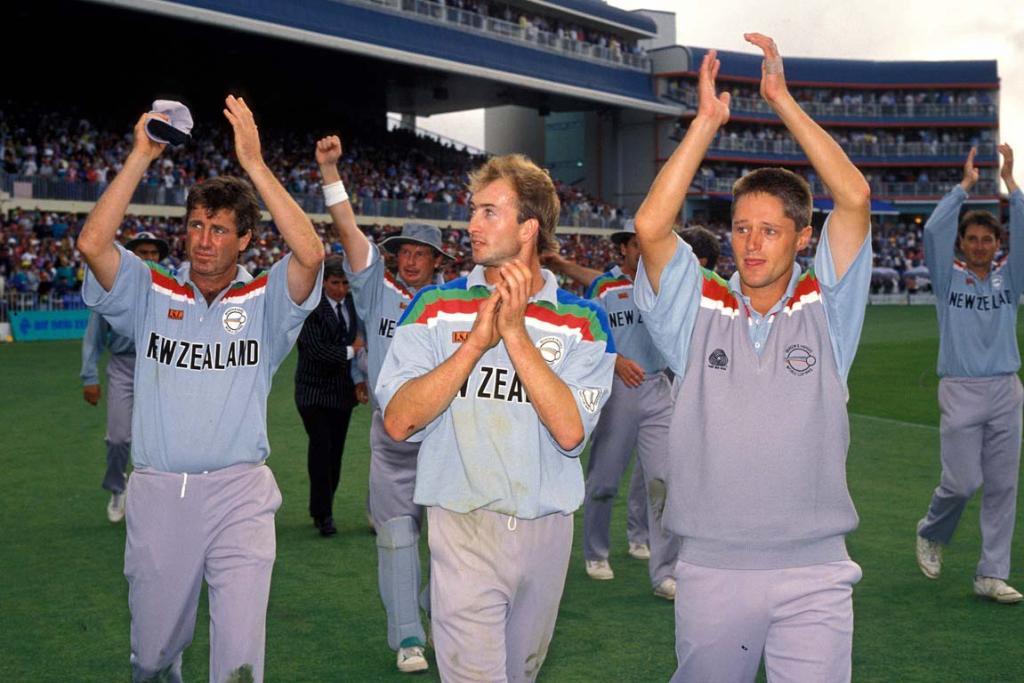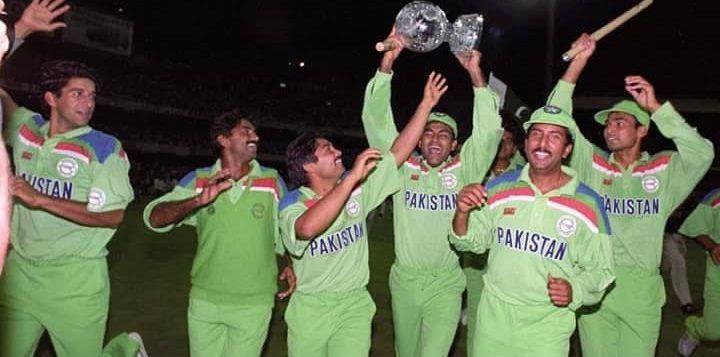- Coloured clothing and day-night matches in floodlights with white balls and black sight-screens.
- The format of the tournament was ‘round-robin’, which meant that each team would play the rest 8 teams once and the top four teams would proceed to semi-final stage.
- The World Cup was being held in the Southern Hemisphere for the first time
- There was also a logo commemorating the World Cup for the first time.
The teams were the same from previous edition, with the addition of South Africa, making it 9 teams in total. South Africa was included as a full member nation for the first time, after ending their ban of 22 years due to ‘apartheid’ – a system of institutionalised racial segmentation in South Africa which oppressed the Black, coloured and Asian South Africans.
India started off poorly, losing the opening match against England, game against Sri Lanka getting
washed out and losing to Australia (incidentally again by the margin of 1 run, as in World Cup 1987). Indian team returned to winning ways in the high voltage match against arch-rivals Pakistan. This was the first time these 2 teams were meeting at a World Cup and the match had its moments of skill and emotions on the field. The most noteworthy effort was of a young Sachin Tendulkar, scoring 54 not out and then taking the crucial wicket of Aamer Sohail, who was playing well and looking set to take Pakistan across India’s total of 216. Sachin was adjudged ‘Man of the Match’ for the 5th time in his career. Little did anyone know at the time that he would go on to win the award for a record 62 times in ODIs! The match is also remembered for the Javed Miandad - Kiran More verbal spat, which resulted in Javed hilariously jumping up and down, visibly irritated by the constant enthusiastic appealing by Kiran More. This match started India’s domination and winning streak over Pakistan in the World Cups, which continues till date. It can only be guessed how India managed to upstage Pakistan in these pressure matches in World Cups, especially during 90’s, when the Pakistan team used to dominate the Indian team comprehensively.
India continued its winning habit by defeating Zimbabwe in next game but crashed out of the contention of a semi final berth by losing its remaining matches to West Indies, New Zealand and South Africa. India finally finished at 7th spot, only above Sri Lanka and Zimbabwe.
Pakistan, on the other hand, had exactly opposite journey. After 5 matches, they were almost out of the tournament with just one win and a match washed out against England (which they would have mostly lost being bowled out for a paltry score of 74). West Indies had already defeated them by 10 wickets in their first match chasing 221. Pakistan had just lost 2 wickets in 50 overs and still just scored 220 and their bowlers didn’t take a single wicket. The situation was completely hopeless. That is when Imran Khan stepped up in his role of leading from the front and motivated his team. He came out for the toss wearing a t-shirt sporting a tiger and gave his now famous ‘cornered tigers’ speech. His motivation bore fruits and Pakistan won their last three matches, including defeating the undefeated New Zealand. Pakistan were helped when Australia defeated West Indies in the last match before knock-out stages, which made Pakistan finish at number four and make a place in semi-final.
On the other hand, South Africa impressed one and all in their debut tournament. They finished third in the table but had some impressive performances in batting, bowling but most importantly, as a fielding unit. This was the World Cup which made Jonty Rhodes famous for his breath-taking agility and accuracy in hitting wickets from the position of ‘Point’. One such incident occurred in the match against Pakistan. The match was well poised and Inzamam-ul-Haq and Imran Khan were playing well to chase down the target. Inzamam was hit on the pads, the ball went to the ‘Point’ region and he decided to take a run. Inzamam had ran few paces when Imran declined the run and he had to turn back. In the meantime, Jonty was also running towards the stumps. Instead of throwing the ball at stumps, he ran and broke down the stumps. It was an exhibition of fielding unseen till now!



On the other hand, South Africa impressed one and all in their debut tournament. They finished third in the table but had some impressive performances in batting, bowling but most importantly, as a fielding unit. This was the World Cup which made Jonty Rhodes famous for his breath-taking agility and accuracy in hitting wickets from the position of ‘Point’. One such incident occurred in the match against Pakistan. The match was well poised and Inzamam-ul-Haq and Imran Khan were playing well to chase down the target. Inzamam was hit on the pads, the ball went to the ‘Point’ region and he decided to take a run. Inzamam had ran few paces when Imran declined the run and he had to turn back. In the meantime, Jonty was also running towards the stumps. Instead of throwing the ball at stumps, he ran and broke down the stumps. It was an exhibition of fielding unseen till now!
Jonty was parallel to the ground, leaping and breaking down all three stumps. That was one of the many runouts in the career of Inzamam, but probably the most memorable one. The newspapers had the following caption for the picture below:
Is it a bird? Is it a plane? No, it’s Jonty Rhodes!
Semi-Finals
New Zealand faced Pakistan in the 1st semi-final at Eden Park, Auckland. The irregular shape of the stadium always makes it tough for visiting teams to create a strategy. New Zealand was in red hot form in round robin stage, topping the group, only losing to Pakistan in the last match. Batting first, New Zealand scored a formidable 262/7, with captain Martin Crowe top scoring with 91. He had a hamstring injury and had to make the decision to field, aggravate the injury and miss the final, or rest during second innings and play in the final. Such was his confidence in his tactics and team that he decided to sit out during the chase.
Trivia: 1992 World Cup will forever be remembered for the brilliant performance of Martin Crowe. As a batsman, he top scored with 456 runs, but more importantly, as a captain, his strategies made New Zealand the favourites to win the title. He was the first captain to opt for a spinner to open the bowling. Dipak Patel proved to be a revelation in that role, and a vital cog in the journey of the team to the semis. In batting, he used Mark Greatbatch as a ‘pinch hitter’ opener, which also proved to be a masterstroke and provided flying starts to the team in initial overs. This trend was later employed by Arjuna Ranatunga in 1996 WC with Sanath Jayasuriya and Romesh Kaluwitharana providing explosive starts to the team at the top of the order.
The chase of Pakistan started sedately. Imran Khan coming in at no. 3 took a lot of deliveries to get to 44. Javed was holding one end steady. Although the strategy which ideally should have been employed by Kiwi bowlers was also not being used as John Wright was the captain, and he missed out the match against Pakistan when Crowe devised the strategy of bowling his bowlers in very short spells, so that the batsmen don’t get used to any bowler. By the time a young, burly, and unknown Inzamam-ul-Haq arrived at the crease, Pakistan needed 123 off last 15 overs. This was a seemingly impossible feat in those days, let alone under the pressure of a world cup semi-final against the home team. This is where John Wright missed the trick. He kept using the same fast bowlers against Inzamam, making him get used to them, and he got off to a flying start. This also meant that the dibbly-dobbly bowler Chris Harris had to bowl in the last 5 overs. The match was lost there only, as later confessed by Martin Crowe, who was edgy and despondent in the dressing room balcony, sitting with a strapped-up leg. Inzamam went berserk, scoring 60 off just 37 balls.
A young Inzamam in full flow in the 1992 Semi Final |
By the time he got run out, the momentum had slipped out of New Zealand’s grasp. Wasim Akram and Moin Khan ably supported Javed Miandad to win a most famous match in Pakistan’s history, with an over to spare. It was a sorry loss for New Zealand, everyone believed they were the best team in the tournament. If not for Crowe’s injury, they might have lifted the cup as he would have used his strategy very well against Pakistan and he believed England was never a competition for the Kiwis. Martin Crowe later revealed, the dressing room after the match was distraught. The worst thing was to take a lap in the ground to thank the supporters. That was probably the first of many such desolate sights in the knock-out stages of the World Cups.
The 2nd semi-final was also an unforgettable match, but for the wrong reasons. In a rain affected match, England scored 252/6 in 45 overs. While chasing, South Africans were never out of it, with each player contributing and at one time, the match was in balance with 22 needed in 13 balls. That is when rain came in again. Using the ‘most productive overs’ method, South Africa were now set a target of 22 runs in 1 ball!
Everyone, not just the South African players, were disgusted by this. Brian McMillan just blocked the ball and players started moving out of the field. English captain Graham Gooch was also embarrassed by this whole fiasco and no English player was really celebrating. That incident caused the administrators to replace this method by ‘Duckworth-Lewis’ method later from 1999 world cup onwards. South Africa again became a victim of rain affected match and revised target miscalculation in 2003 World Cup and got knocked out of group stages in a world cup hosted by the Rainbow nation themselves.
Final
The final was a thriller, which again, due to Pakistan’s batting, started off sedately. Imran took his own sweet time to get going, and only the support from Javed and cameos from Wasim and Inzamam got Pakistan to a good total of 249/6. Putting the score on the board in a final is always better, as the scoreboard pressure is always there on chasing team. While chasing, England were shaken early but Allan Lamb and Neil Fairbrother added 72 runs to take England to 141/4. That is when Wasim Akram was reintroduced into the attack. In a man of the match performance, he removed Allan Lamb and Chris Lewis in successive balls, to tilt the match towards Pakistan. In the end, England fell 22 runs short and Pakistan won by 22 runs. This was last match for Imran Khan. He had come out of retirement and he retired after winning the cup for the country.
DHCF Nishant Raizaday for diehardcricketfans
No comments :
Post a Comment